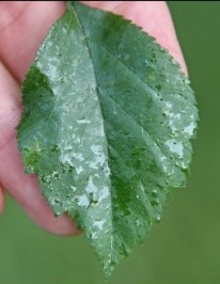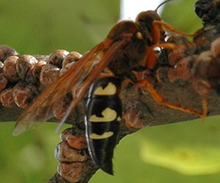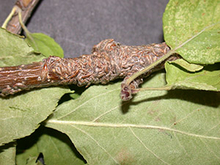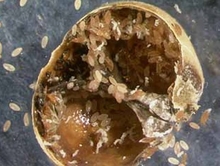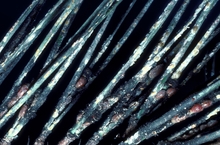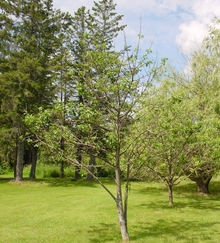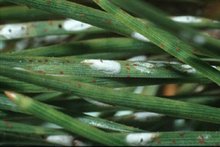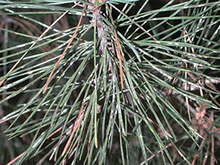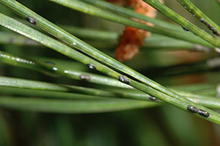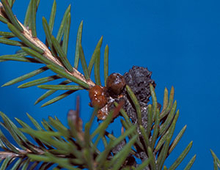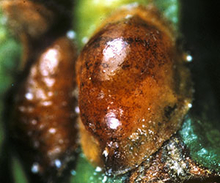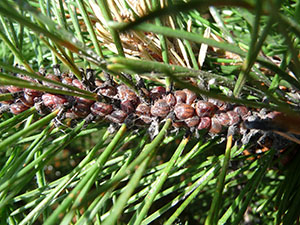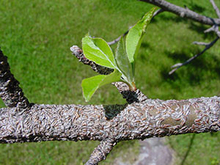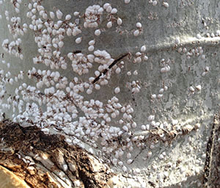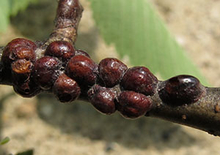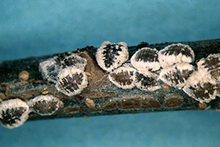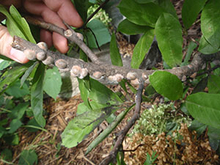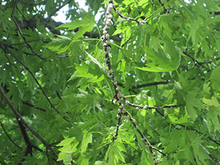Quick facts
- Scale insects are common on many trees and shrubs.
- Although natural enemies help keep them in check, scales sometimes can become numerous and seriously injure plants.
- Identification of the scale species is important to choose the most effective way to manage them.
- There are a variety of low impact and residual insecticides available to treat scales; correct timing is critical for successful management.
How to identify scales
There are two types of scales: soft scales or armored scales. Both types live under a covering they produce.
Soft scales
- Convex and about 1/8 to 1/4 inch long.
- Feed on the phloem tissue of trees and shrubs.
- Excrete excess sap from the phloem as a by-product called honeydew.
If you see honeydew, look closely for signs of soft scales.
- Honeydew will stick leaves together and attract many insects (ants, wasps and flies) that feed on the excretions.
- Other insects like aphids and wooly aphids can also produce honeydew.
Armored scales
- Smaller than soft scales (about 1/16 to 1/8 inch long) and usually oval or somewhat elongate.
- Feed on individual plant cells (instead of the phloem) and do not produce honeydew.
- Many armored scales match the color of the bark of their host tree and are not spotted until the damage is noticeable.
- An exception to this are pine needle scales; they have bright white shells in contrast to the green needles on which they feed.
Biology of scale insects
Scale insects have three stages in their development: eggs, crawlers, adults.
- They first start as eggs laid under the shell of the females.
- The eggs hatch into nymphs, commonly called crawlers.
- They move from under the cover of the scales to colonize other sites on the plants.
- There are two instars (growth stages) of nymphs.
The crawler stage of scale insects is the primary method of dispersal. The crawlers are small enough to be blown by wind to other plants and are also able to be transferred on feet of birds and other animals that frequent the trees on which they feed.
Soft scales
- Crawlers typically move out to feed on foliage and the second instar (growth stage) nymphs return to twigs and branches to mature and build their own protective shells.
- Retain their tiny legs and are able to move but very slowly.
Armored scales
- Travel to new plant tissues (rarely leaves) and settle down to feed, creating new coverings near the adult scales.
- Lose their legs and become non-mobile, remaining in the same location for the remainder of their life.
When fully grown, female scales mate with winged males (rarely seen) and lay eggs under their protective shell cover and die.
Different scales overwinter in different stages.
- Soft scales overwinter as nymphs or adults
- Armored scales overwinter as eggs under the hard shell of their mothers.
This difference in overwintering habits as well as timing of the crawler stages of each of the scale species is very important to determine the best management methods as well as the best timing of management.
Injury caused by scales
Scale numbers can increase rapidly after just a few seasons. A plant can literally be covered with scales before the problem is noticed. Injury doesn’t usually become obvious until scale populations reach outbreak levels.
Armored scale insects are typically more damaging to their hosts than soft scales.
- Their feeding on branch tissues kills individual cells.
- Cell death disrupts the transportation of materials through the tree limb and can cause the branch to die.
- In heavy infestations armored scales feeding on branch tissues can cause the death of entire plants.
- Limb death is often the first indicator that there is a scale problem on the plant.
Armored scales that feed on foliage kill individual cells as well. Damage is observed as purpling and yellowing of foliage and loss of foliage to which the scales are attached.
Soft scales are frequently identified by the honeydew they produce on infested plants.
- Honeydew supports the growth of sooty mold on the leaves of plants, but it is not directly damaging to plants.
- In severe soft scale infestations damage occurs on individual limbs before it impacts the entire canopy.
- Observable soft scale insect damage can range from deformed leaves and branch tip dieback to limb death and loss of sections of the canopy.
How to protect your trees from scales
Scale insects are usually kept below damaging numbers by natural enemies like lady beetles and tiny parasitic wasps. However, when biological control is not sufficient, scale numbers can become abundant, requiring management.
It is important to properly identify the scale species present. This will tell you when scale crawlers are most likely to be active. The crawler stage is when scales are most vulnerable to management.
Start to look for the presence of crawlers just before they are expected to appear.
- Shake infested branches over a white sheet of paper or white paper plate to look for reddish or yellowish colored crawlers.
- Place double-sided tape on branches where scales are present. Check the tape for crawlers.
- Check for crawlers at least once a week until you find them.
The best time to treat most scale insects is after eggs hatch when the crawlers are first active and are searching for feeding sites, but before they begin producing their shells.
Low impact pesticides
Insecticidal soaps and horticultural oils are effective sprays
- They have minimal impact on natural enemies, helping to preserve them.
- They can be used to manage most crawlers when properly timed.
- Scales with extended periods of egg hatch may require repeat applications for effective management since soaps and oils only affect crawlers they directly contact.
Horticultural oils can be applied in late winter or early spring as a dormant treatment.
- This is only effective against species that overwinter as crawlers or adults.
- It is not effective against scales overwintering as eggs.
Insect growth regulators are also effective low impact pesticides.
- Insect growth regulators (IGRs) prevent immature nymphs from developing into functioning adults.
- These insecticides do not affect adults.
- These products help conserve natural enemies that are present.
- Pyriproxyfen (e.g. Distance) and buprofezin (e.g. Talus) are effective IGRs; they are available only to licensed applicators.
Residual contact insecticides
There are a variety of residual insecticides available to treat scales.
- Time their application to coincide when crawlers are active.
- These insecticides include pyrethroids (such as permethrin, bifenthrin, lambda cyhalothrin) and carbaryl.
- These products generally last one to two weeks after they have been applied.
Systemic pesticides
Systemic insecticides are transported by trees and shrubs through the conductive tissue (xylem and phloem).
- Imidacloprid is applied as a liquid drench to the soil around the trunk of the tree (professional applicators can also apply it as a soil injection or a trunk injection).
- Dinotefuran is applied as granules to the soil directly around the tree (professional applicators can also apply it as a bark spray, soil drench or soil injection).
- Imidacloprid is effective at managing most soft scales, although it is not effective against armored scales.
- Dinotefuran is more mobile in plants and effectively reduces both soft and armored scales.
Protect bees from systemic pesticides
To protect bees, take these precautions:
- Be careful when applying systemic pesticides to hardwood trees and shrubs that are attractive to bees, such as linden or basswood, crab apple, sugar maple, as well as juneberry (serviceberry), pagoda dogwood, nannyberry viburnum and many other shrubs (Go here for a list of bee attractive trees and shrubs.
- Apply systemic pesticides after flowering to reduce pesticide exposure to bees.
- If this timing does not match with the time when crawlers are active, use another control method.
- Do not use systemic pesticides that are applied to the soil when flowers that attract bees are planted next to trees or shrubs.
Professional services
Commercial tree care companies have experience in managing scale insects and in handling and applying pesticides. They also have access to products and procedures to manage scale insects that are unavailable or unfamiliar to residents. When treating trees is not practical for residents, consider hiring a licensed pesticide applicator.
CAUTION: Mention of a pesticide or use of a pesticide label is for educational purposes only. Always follow the pesticide label directions attached to the pesticide container you are using. Be sure that the area you wish to treat is listed on the label of the pesticide you intend to use. Remember, the label is the law.
Scales on conifers
Open the drawers to find pictures and more information about the types of scales found on conifers in Minnesota.
- Pine needle scale
- Black pineleaf scale
- Small spruce bud scale
- Fletcher scale
- Pine tortoise scale
Pine needle scale
(Chionaspis pinifoliae)
Appearance: White, oval-elongate scales, 1/8 inch (2.5-3 mm) long.
Hosts: Pine, spruce, fir, hemlock and Douglas fir.
Damage:
- Light to moderate feeding cause needles to turn yellow and drop.
- Heavy, persistent infestations can reduce the vigor in trees, but this is uncommon.
Life cycle:
- Eggs laid in the fall overwinter beneath the dead mother scale and hatch in mid-late May.
- Mobile crawlers feed on new needles where they form their scale shell.
- One generation per year in Minnesota.
Management
Spray treatment for crawler stage:
- Insecticidal soaps and horticultural oils.
- Insect growth regulators (pyriproxyfen and buprofezin are available only to licensed applicators).
- Residual insecticides (acephate, pyrethroids, carbaryl).
- Time crawler spray applications for when crawlers are active for effective control.
Systemic management:
- Use dinotefuran as a soil application or as a bark treatment in the spring.
- Combine systemic treatment with a crawler spray for the most effective management.
Black pineleaf scale
(Nuculaspis californica)
Appearance: Black, oval-elongate with gray margins and a whitish or yellow round center, 1/12 -1/10 inch (1.5-2.0 mm) long.
Hosts: All pine species and Douglas fir.
Damage:
- Light to moderate feeding causes needles to turn yellow and drop.
- Severe infestations can cause needle stunting and death in young trees and weakening of mature trees.
- This scale can be associated with stressed trees.
Life cycle:
- Black pineleaf scales overwinter as immature scales.
- Adults are present during late spring.
- Eggs hatch in mid-late July and mobile crawlers feed on new needles into August.
- Crawlers turn into second instar nymphs and are found until spring.
- One generation per year.
Management
Spray treatment for crawler stage:
- Insecticidal soaps and horticultural oils.
- Insect growth regulators (pyriproxyfen and buprofezin are available only to licensed applicators).
- Residual insecticides (acephate, pyrethroids, carbaryl).
- Time crawler spray applications for when crawlers are active for effective control.
Systemic management:
- Use dinotefuran as a soil application or as a bark treatment in the spring.
- Combine systemic treatment with a crawler spray for the most effective management.
Small spruce bud scale
(Physokermes hemicryphus)
Appearance:
- Globular, reddish-brown, adult females are found in clusters of 3 to 8 individuals at the base of new growth.
- They closely resemble the buds of their host tree.
Hosts: Spruce, particularly Norway spruce.
Damage:
- Lower branches are most commonly attacked. This causes branch death, reduced tree strength and slow tree growth.
- Large amounts of honeydew are produced along with black sooty mold.
Life cycle:
- Overwinter as nymphs on undersides of needles.
- Females move to twigs in April and complete development.
- Crawlers appear in mid-June and feed on new growth.
- One generation per year.
Management
- Apply horticultural oils in late fall and early spring to smother overwintering nymphs.
- Apply systemic treatment of dinotefuran in the spring.
Spray treatment for crawler stage:
- Insecticidal soaps and horticultural oils.
- Insect growth regulators (pyriproxyfen and buprofezin are available only to licensed applicators).
- Residual insecticides (acephate, pyrethroids, carbaryl).
- Time crawler spray applications for when crawlers are active for effective control.
Fletcher scale
(Parthenolecanium fletcheri)
Appearance: Round, brown scales on twigs, at the base of the needles.
Hosts: Yew, arborvitae and juniper.
Damage:
- Weakens plants, causing foliage to drop.
- Large amounts of honeydew result in noticeable black sooty mold growth.
- It is a serious pest of yew.
Life cycle:
-
Overwinter as nymphs on branches.
-
Grow quickly in spring and produces noticeable damage and honeydew.
-
Mature females lay eggs in May that hatch in mid-late June.
-
Newly hatched crawlers look for feeding and overwintering sites.
-
One generation per year.
Management
- Apply horticultural oils in late fall and early spring to smother overwintering nymphs.
- Apply systemic treatment of dinotefuran in the spring.
Spray treatment for crawler stage:
- Insecticidal soaps and horticultural oils.
- Insect growth regulators (pyriproxyfen and buprofezin are available only to licensed applicators).
- Residual insecticides (acephate, pyrethroids, carbaryl).
- Time crawler spray applications for when crawlers are active for effective control.
Pine tortoise scale
(Toumeyella parvicornis)
Appearance: Adult females are reddish-brown, wrinkled, helmet-shaped and occur in clusters on twigs.
Hosts: Scots, jack, red, Austrian and other pines.
Damage:
- Needles become off-colored and stunted, with trees taking on an overall pale, thin appearance.
- Annual, heavy infestations can kill branches or entire trees.
- Large amounts of honeydew can attract wasps and also cause trees to turn black due to sooty mold growth.
Life cycle:
- Live through the winter as fertilized females on branches.
- Females greatly enlarge by late spring and lay eggs.
- Tiny crawlers appear in late June to early July and begin feeding on needles.
- Nymphs mature and mate.
- Females then seek overwintering sites on twigs and branches.
- One generation per year.
Management
- Apply horticultural oils in late fall and early spring to smother overwintering nymphs.
- Apply systemic treatment of dinotefuran in the spring.
Spray treatment for crawler stage:
- Insecticidal soaps and horticultural oils.
- Insect growth regulators (pyriproxyfen and buprofezin are available only to licensed applicators).
- Residual insecticides (acephate, pyrethroids, carbaryl).
- Time crawler spray applications for when crawlers are active for effective control.
Scales on deciduous trees
Open the drawers to find pictures and more information about the types of scales found on deciduous trees in Minnesota.
- Oystershell scale
- Scurfy scale
- Lecanium scale
- European elm scale
- Magnolia scale
- Cottony maple scale
Oystershell scale
(Lepidosaphes ulmi)
Appearance: Purplish-gray, about 1/8 inch (3 mm) long and shaped like tiny oyster shells.
Hosts: Lilac, apple, poplar, birch, ash, cotoneaster, willow and many other deciduous trees and shrubs.
Damage:
- Cracked bark and yellowish (chlorotic), stunted leaves.
- Heavy infestations can kill trees or expose them to secondary pests such as borers.
Life cycle:
- Overwinter as eggs beneath the dead mother's scale.
- Crawlers hatch in late May to early June and seek suitable feeding sites on branches and trunks.
- Nymphs mature in mid-summer to mate.
- Eggs are laid in late summer to early fall beneath the mother's scale.
- One generation per year.
Management
Spray treatment for crawler stage:
- Insecticidal soaps and horticultural oils.
- Insect growth regulators (pyriproxyfen and buprofezin are available only to licensed applicators).
- Residual insecticides (acephate, pyrethroids, carbaryl).
- Time crawler spray applications for when crawlers are active for effective control.
Systemic management:
- Use dinotefuran as a soil application or as a bark treatment in the spring.
- Combine systemic treatment with a crawler spray for the most effective management.
Scurfy scale
(Chionaspis furfura)
Appearance:
- Females are flat, pear-shaped, dirty whitish-gray and about 1/8 inch (3 mm) long.
- Males are similar in appearance but smaller.
Hosts: Crabapple, poplar, birch, mountain ash, cherry, plum and many other deciduous plants.
Damage:
- Feeding by the scales can cause twig and branch dieback and weaken plants.
Life cycle:
- Overwinter as eggs under the dead mother scale on branches and trunks.
- Crawlers appear in June and begin feeding on leaves, branches and trunks.
- Nymphs mature in August, mate and lay overwintering eggs.
- Usually one generation per year in Minnesota, but a second generation may occur.
Management
Spray treatment for crawler stage:
- Insecticidal soaps and horticultural oils.
- Insect growth regulators (pyriproxyfen and buprofezin are available only to licensed applicators).
- Residual insecticides (acephate, pyrethroids, carbaryl).
- Time crawler spray applications for when crawlers are active for effective control.
Systemic management:
- Use dinotefuran as a soil application or as a bark treatment in the spring.
- Combine systemic treatment with a crawler spray for the most effective management.
Lecanium scale
(Parthenolecanium spp.)
Appearance:
- Females are initially flattened and brown in appearance. As they mature, they become hardened and round.
- Lecanium scales are difficult to distinguish one from another.
- Most common lecanium scale on Minnesota deciduous plants is the European fruit lecanium scale (Parthenolecanium corni).
Hosts: Oak, maple, crabapple and a wide variety of other trees and shrubs.
Damage:
- Dieback of twigs and branches and entire plants can occur in heavy infestations.
Life cycle:
- Scales overwinter as second instar nymphs on twigs.
- In spring, scales mature and females lay eggs in May and June.
- Crawlers hatch in June and July and migrate to leaves to feed.
- In late summer, crawlers migrate back to twigs to overwinter.
- One generation per year.
Management
- Apply horticultural oils in late fall and early spring to smother overwintering nymphs.
- Apply systemic treatments of imidacloprid in the fall or dinotefuran in spring.
Spray treatment for crawler stage:
- Insecticidal soaps and horticultural oils.
- Insect growth regulators (pyriproxyfen and buprofezin are available only to licensed applicators).
- Residual insecticides (acephate, pyrethroids, carbaryl).
- Time crawler spray applications for when crawlers are active for effective control.
European elm scale
(Gossyparia spuria)
Appearance: Mature females are up to 2/5 inch (10 mm), oval and brown with a white, waxy fringe.
Hosts: Elm, especially American elm.
Damage:
- Scale feeding can cause stunted, chlorotic (yellowed) leaves, premature leaf drop and branch dieback.
- Black sooty mold growing on honeydew secretions can blacken infested limbs.
Life cycle:
- Scales overwinter as second instar nymphs in bark cracks and crevices.
- Females mature in late May, mate and begin laying eggs.
- Egg hatch may last up to the end of July, as crawlers start appearing in late June.
- Crawlers feed on leaves throughout the summer, and then migrate to branches before leaves drop in the fall.
- One generation per year.
Management
- Apply horticultural oils in late fall and early spring to smother overwintering nymphs.
- Apply systemic treatments of imidacloprid in the fall or dinotefuran in spring.
Spray treatment for crawler stage:
- Insecticidal soaps and horticultural oils.
- Insect growth regulators (pyriproxyfen and buprofezin are available only to licensed applicators).
- Residual insecticides (acephate, pyrethroids, carbaryl).
- Time crawler spray applications for when crawlers are active for effective control.
Imidacloprid is highly effective against this species.
Magnolia scale
(Neolecanium cornuparvum)
Appearance:
- Females are about 1/2 inch (12 mm) in diameter, smooth, elliptical, spherical, pinkish-orange to brown insects that are covered with a waxy coating.
- Overwintering nymphs are dark gray with a red-brown ridge down the middle.
Hosts: Magnolia.
Damage:
- Infested branches and twigs can be weakened and growth slowed.
- Honeydew created by the scales attracts ants, wasps and other insects.
- Honeydew and sooty mold affects the primary host as well as neighboring plants.
- Heavy infestations covering branches can cause branches and entire plants to die.
Life cycle:
- Live through the winter as nymphs on one- or two-year-old twigs.
- Nymphs mature in late July through early August.
- Crawlers hatch in late August or early September and overwinter on young twigs.
- One generation per year.
Management
- Magnolia scale populations can build rapidly within one generation. Pesticide treatments should be made the same season they are observed on the plant.
- Apply horticultural oils in late fall and early spring to smother overwintering nymphs.
- Scales can be effectively managed when fall and spring horticultural oil sprays are combined with a systemic insecticide in the spring.
Spray treatment for crawler stage:
- Insecticidal soaps and horticultural oils.
- Insect growth regulators (pyriproxyfen and buprofezin are available only to licensed applicators).
- Residual insecticides (acephate, pyrethroids, carbaryl).
- Time crawler spray applications for when crawlers are active for effective control.
Cottony maple scale
(Pulvinaria innumerabilis)
Appearance:
- The most noticeable stage is the brown adult female with a large cottony mass (egg sack) protruding from the rear.
- Females without egg sacs are 1/8 inch (2-3 mm) long, flat, pale to dark brown and soft.
Hosts: Maples (especially silver), honeylocust, linden and other hardwoods.
Damage:
- No significant damage to plant health as natural enemies control this insect well.
- Large amounts of honeydew support sooty mold growth.
Life cycle:
- Live through the winter as immature, flat females on twigs.
- Begin growing in May and the white egg sacs appear by early June.
- Crawlers hatch in late June to early July and move to the undersides of leaves to feed.
- Mated females move back to twigs for the winter.
- One generation per year.
Management
- Cottony maple scale infestations are usually controlled by natural enemies and do not usually need to be managed.
- Apply horticultural oils in late fall and early spring to smother overwintering nymphs.
- Apply systemic treatments of imidacloprid in the fall or dinotefuran in spring.
Spray treatment for crawler stage:
- Insecticidal soaps and horticultural oils.
- Insect growth regulators (pyriproxyfen and buprofezin are available only to licensed applicators).
- Residual insecticides (acephate, pyrethroids, carbaryl).
- Time crawler spray applications for when crawlers are active for effective control.
Reviewed in 2021


